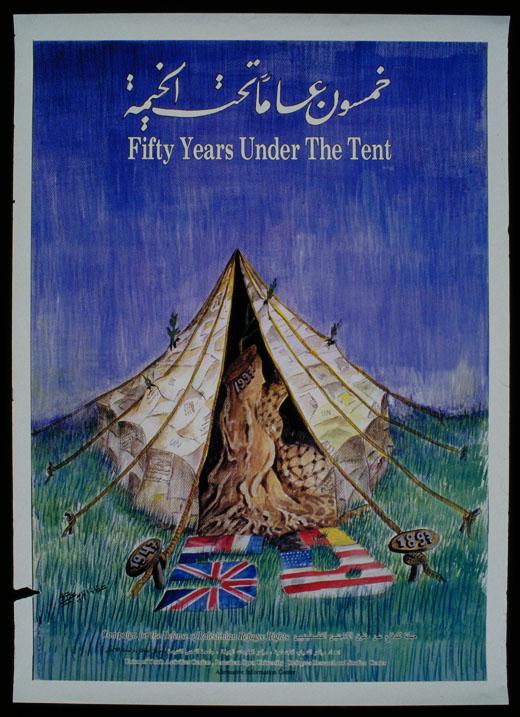Fifty Years Under the Tent
In this poster the central visual element is the stump of an olive tree situated within a ragged, extensively patched khayma (Arabic: tent). This poster was printed in 1997 to mark the fiftieth anniversary of the 1947 UN Partition Plan for Palestine as well as the disappearance of historic Palestine the following year as a result of the United Nations' formal recognition of Israel as a state, an event the Palestinians call the Nakba (Arabic: catastrophe).
The number 50—the number of years the Palestinians have spent "under the tent"—is marked out on the grass in front of the tent in the form of a tattered welcome mat made up of the flags of the four countries the Palestinians hold particularly responsible for their diaspora: France for its virulent anti-Semitism epitomized by the Dreyfus Affair (1895-1906); The UK for the Balfour Declaration (1917), and the British Mandate (1918-1948); Germany for perpetrating the Holocaust a genocide against the Jewish people which drove many of its survivors to flee to Palestine as refugees; and the USA for its uncritical military, economic and political support of Zionism, and by extension, Israel.
The clothe patches that make up the body of the tent are remnants of wheat and flour sacks from the UN and the US's Agency for International Development (AID). The AID sacks have a printed text in Arabic that reads: "A gift from the American people. Not for resale or commercial use."
Inside the tent is the stump of a still-living olive tree. This tree stump represents the Palestinian people. Several shoots can be seen piercing the tent perhaps representing generations of Palestinians who have endured dispossession, refugeehood and exile yet remained committed to the goal of al awda (Arabic: return). In Palestinian political terms this limitless commitment to the land of Palestine is called sumud (Arabic: steadfastness). Sumud is a heroic expression of Palestinian political will and this poster was published with the intent of heroicizing those Palestinians who have been the backbone of the Palestinian revolutionary movement: the refugees.
Part of the stump's root system has morphed into the pattern of the Palestinian kaffiyeh (a black and white cotton headdress) exemplifying the fusion of the tree's determination to persevere, even in its truncated, vulnerable state, with pan-Palestinian political culture. The inclusion of the kaffiyeh, an article of dress worn by men and increasingly, women, from across the Palestinian political spectrum affirms the olive tree's iconic role for Palestinians irrespective of their personal political affiliation. The uppermost portion of the tree, representing the geographic aspect of historic Palestine though cut down, regenerates itself via the shoots. In this way the tree's natural tenacity to survive and renew itself, even in its foreshortened state and even in the harshest of circumstances is seized upon by the Palestinians as being emblematic of their revolutionary commitment and survivability.
In front of the tent there are two stakes, one each to the left and right of the tent's entrance, that anchor stabilizing ropes. The brass hammering caps of these stakes are in the form of plaques cast with the dates "1947" on the left hand side, and "1897" on the right hand side. Near to the top of the stump the date "1997" has been carved into the bark. The "fifty years under the tent" referred to in the poster's title are the years between 1947, the year of the UN's Partition Plan for Palestine when the first Palestinian refugee camps were created and 1997, the fiftieth anniversary of that event.
Perhaps the most significant, if utterly obscure, element of this poster is the plaque holding the date "1897". This is critical knowledge because it is the only direct reference in the poster to Zionism. As such, it is the only clue that might inform an uninitiated viewer as to the authentic origins of the conflict. The year 1897 was the year in which Theodor Herzl mobilized the scattered and fractious elements of the Jewish diaspora and successfully launched the processes that led to the emergence of Israel in 1948. For Palestinians, this date is not included as a reminder; every Palestinian man, woman or child knows what that date means and does not need to be reminded. Rather, its inclusion is an indictment: it is public refutation of Zionism's assertion of ownership of the land based on ancient history. This poster fixes the origination of Zionism's territorial claim to a much more recent date and re-iterates the Palestinian assertion that the antisemitism that gave rise to Zionism, and later the Holocaust, was not a product of Arab, Islamic or Palestinian culture but rather arose in Europe.
By claiming the olive tree as an iconic representation of their national revolutionary spirit the Palestinians identify with its rootedness, as opposed to the Zionist's identification with the pine tree’s transplantibility (a metaphor for immigration and settler colonialism). It is the deep and tenacious root system of the olive tree that explains its legendary longevity and ability to withstand drought and disease which make it the pre-eminent symbol of Palestinian political will. In Palestinian political iconography, as exemplified by this poster, the land itself is seen as a living organism, one that is seeing to the tree's continued fertility. There are no people depicted in the poster because the tree itself represents the people.
This poster reminds the viewer of a fact poorly understood by most Americans: that with its vote to recognize Israel as a state in May of 1948 the UN simultaneously closed the revolutionary moment of one nationalist movement—political Zionism—and opened that of another—Palestinian nationalism. One people came in from an unjust and immoral exile…and another was cast out into one.
Source: Text from Arab Studies athropology course (MAAS 554) Georgetown University, Fall 2008, written by Dan Walsh.
This poster is meant to be viewed in concert with another poster at this site: And We Will Set Down Roots Here

